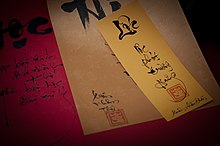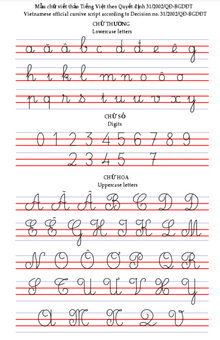
Vietnamese calligraphy

This article needs additional citations for verification. (December 2016) |
| Part of a series on |
| Calligraphy |
|---|
 |


Vietnamese calligraphy (Vietnamese alphabet: Thư pháp Việt Nam, chữ Hán: 書法越南) relates to the calligraphic traditions of Vietnam. It includes calligraphic works using a variety of scripts, including historical chữ Hán (Chinese characters), chữ Nôm (Vietnamese-derived characters), and the Latin-based Vietnamese alphabet. Historically, calligraphers used the former two scripts. However, due to the adoption of the Latin-based chữ Vietnamese alphabet, modern Vietnamese calligraphy also uses Latin script alongside chữ Hán Nôm.[1]

Traditional Vietnamese calligraphy is strongly affected by that of China. Chữ Hán was often used as a literary language in ancient Vietnam, and as a result, Vietnamese calligraphy also used to follow Chinese calligraphy’s standard and used chữ Hán in many of its writings. For example, during the Lý dynasty, its style was similar to China’s Tang dynasty (618-907). During the Trần dynasty, it was influenced strongly by China’s Song (960-1279) and Yuan (1271-1368) dynasties.[2]

Nonetheless, over time, Vietnam developed its own styles of calligraphy historically for writing both Chữ Hán and Chữ Nôm. In the later Lê dynasty, Vietnam developed a unique style of calligraphy called Nam tự (lit. 'southern script', 南字) by Phạm Đình Hổ (範廷琥) in his book Vũ Trung Tùy Bút ('Written on Rainy Days', 雨中隨筆).[3] It was first used in bureaucracy only but later became popular for all writing purposes. It was also called Lệnh thư (lit. 'script for decrees', 令書) in Việt Sử Toát Yếu ('Vietnamese History and Compendium', 越史撮要) because of its initial bureaucratic characteristic.[4]


In modern times, calligraphy has been done frequently in the Latin-based Vietnamese alphabet, as chữ Nôm and chữ Hán have largely fallen out of use.[5] Chữ quốc ngữ calligraphy gained popularity during the New Poetry and Free Poetry Movements, due to the increasing popularity of using the Vietnamese vernacular, as well as influence from French literature. Modern Vietnamese calligraphy is influenced by modern Latin cursive but is written using the calligraphy brush, rather than quill or reed pens as is done in Western calligraphy. Vietnamese calligraphy can be used to write poems, festive banners, signage, and so on.

Vietnamese calligraphy artwork
-
People writing calligraphy on Tết Nguyên Đán in Hanoi.
-
A stall selling chữ Hán calligraphy.
-
A calligrapher writing Tính, which means 'to ponder' or 'figure out'.
-
The word Nhẫn.
-
The word Việt.
-
"Boat People": The picture of the people on the boat spell out Thuyền nhân, literally meaning 'Boat People'.
-
The word Tâm, which can mean 'soul', 'heart', or 'mind'.
-
Chữ Quốc-Ngữ written on a scroll.
-
A Vietnamese calligrapher writing 祿 (lộc, 'good fortune') in preparation for Tết at the Temple of Literature, Hanoi.
-
Vietnamese calligraphy from the Temple of Literature.
-
Vietnamese in the Nguyễn Dynasty practicing calligraphy.
See also
References
- ^ VietnamPlus (February 9, 2022). "Vietnamese Traditional Calligraphy During Tet | Festival | Vietnam+ (VietnamPlus)". VietnamPlus. Retrieved February 9, 2022.
- ^ "New book tells story of VN calligraphy". Vietnam News. Retrieved March 19, 2018.
- ^ Vũ Trung Tùy Bút (in Vietnamese).
- ^ Việt Sử Toát Yếu (in Vietnamese).
- ^ "Vietnamese neglect Han-Nom heritage". Viet Nam News. February 14, 2012. Retrieved December 18, 2013.
See what we do next...
OR
By submitting your email or phone number, you're giving mschf permission to send you email and/or recurring marketing texts. Data rates may apply. Text stop to cancel, help for help.
Success: You're subscribed now !












